Best Art Books of 2023 – The New York Times
[ad_1]
Best Art Books of 2023 The New York Times
[ad_2]
Source link
[ad_1]
Best Art Books of 2023 The New York Times
[ad_2]
Source link
[ad_1]

Chosen by Adam Nathaniel Furman, artist and designer
A brilliant celebration of one of the greatest – but not exhibited enough – British textile designers, this show is the kind of celebration of the power of craft and design that we need to see more of. The wonderful exhibition design by the amazing Bushra Mohamad/Msoma Architects and Nana Biama-Ofosu/YAA Projects was an exemplary instance of how small projects can be brilliant platforms for showcasing the very best of upcoming new talent. The show, while small, was an iconic marker of a new approach to architecture in the UK by two of its brightest and most interesting young stars.

Chosen by Dr Samuel Ross, product and fashion designer
Mac’s vernacular conveys a chapter of intergenerational British-Caribbean experiences that mediate what it is to partake within British society whilst navigating knowing that your genealogy, is not that of your birthplace.
His ebonised ash timber sculpture ‘Runout’ seeks to combine the study of geography, essence and belonging through form, select treated materials and familiar yet lucid objects – including the domino and what appears as a deity-influenced form – relevant to West Africa’s Kingdom of Benin.
Mac Collins is a recipient of the 2021 Black British Artist Grants programme, founded by Samuel Ross

Chosen by Minnie Moll, chief executive, Design Council
These headphones for children are my pick of the year as the circular manufacturing company Batch.Works and design consultancy Morrama Lab have truly put the planet at the heart of their design. They have considered modularity to allow them to be easily repaired and adapted to fit as children grow. Materiality is addressed with parts 3D printed from biodegradable plastic, and circularity by developing a tracking method for recycled components. We need more ingenious designs like this for products that respect our planet.

Chosen by Joseph Henry, urbanist and co-founder of Sound Advice
A House for Artists is an incredible piece of architecture by emerging practice APPARATA, supported by the Mayor of London, London Borough of Barking & Dagenham and Create London. We never think about the role of the public sector in design but this project is a demonstration of how it can use design and design thinking to be innovative to deliver social impact. The creative industries are one of the most important sectors in the UK, but we have a lack of infrastructure in place to support the people who produce the amazing work that enriches our lives. A House for Artists is a great blueprint for how we can deploy designs at a strategic level through mission driven partnerships.
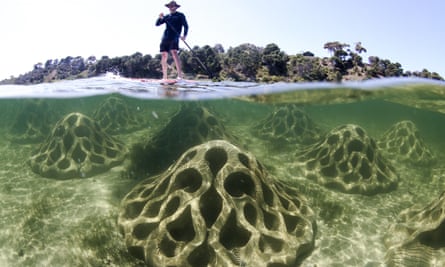
Chosen by Shelley Simpson, designer and founder of Mud Australia ceramics
We spend a lot of time near and in the sea so we are very aware of the impact of climate change on the ocean and harbour where we live in Sydney. Alex Goad is from the latest generation of designers who have inherited this mess and are practically oriented towards fixing it. The erosion mitigation units installation in Corio Bay at Geelong, Victoria, uses 200cm wide units of ecoblend concrete and seashell aggregate to poetically address and resolve site-specific erosion and habitat damage in coral reefs. All of his work has a real-world practical application but also makes you question how we got here.
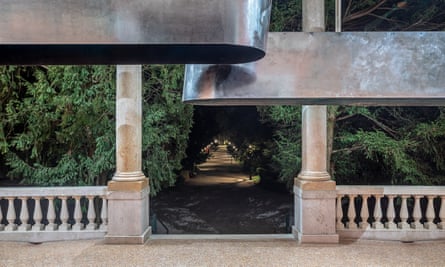
Chosen by Charlene Prempeh and Lewis Gilbert of creative agency A Vibe Called Tech
“There is reason, after all, that some people wish to colonize the moon, and others dance before it as an ancient friend,” was the James Baldwin quote that served as the provocation for Dancing Before the Moon, the British Pavilion presentation at the 18th Venice Architecture Biennale. Individually the collective of curators are brilliant – Jayden Ali designed the hugely celebrated Fashion Masculinities at the V&A, Joseph Henry is currently the Loeb fellow at Harvard, Meneesha Kellay is the senior curator, contemporary at the V&A and Sumitra Upham is head of programmes at the Crafts Council – and together, there was a certain alchemy that made the exploration of spatial practice for diasporic communities both gleeful and momentous.
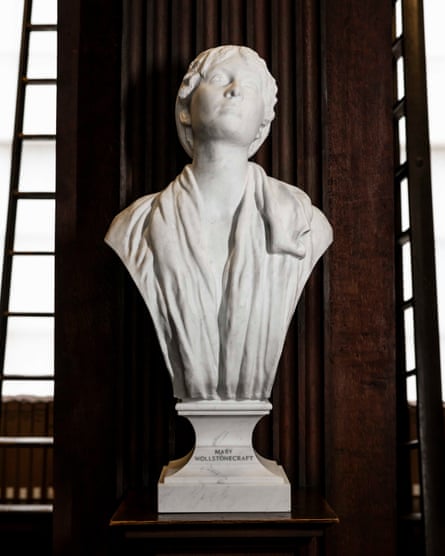
Chosen by Katy Hessel, art historian and author of The Story of Art Without Men
On St Brigid’s Day (1 February) four portrait busts of women, for the first time, were installed in Trinity College’s Old Library, alongside 40 marble busts of men (a collection that began in 1743). Represented are: scientist Rosalind Franklin; dramatist Augusta Gregory; mathematician Ada Lovelace; and feminist rights activist Mary Wollstonecraft. What I love about this is that each bust, constructed by a woman artist, corresponds to the trailblazing woman’s accomplishments – for example, the crystals worn by Rosalind Franklin reference her use of X-ray crystallography to research the structure of DNA, and Lovelace’s 3D-scanned portrait has appropriately been constructed using techniques enabled by computer programmes.

Chosen by artist and designer Yinka Ilori
I want to nominate socially minded design practice POoR Collective’s work. There is something extremely powerful about giving a voice to the voiceless, especially in spaces where their voices are the fabric of a community. It’s been beautiful to see them win the Emerging Design Medal at the London Design Festival this year and their work on projects such as the Malorie Blackman exhibition at the British Library. Public space is important more than ever I’m excited to see what the future of public spaces look like with their intervention”
after newsletter promotion

Chosen by Jen Roberts, CEO, Design Miami
Great design should shape the way we live for the better. That’s why my design of the year comes from OPEN Architecture – a practice that continually challenges the way we interact with the spaces around us. The Shanfeng Academy, designed as a cultural and sports centre for Mountain Kingston Bilingual School in a new district of Suzhou, China – is a strikingly thoughtful project. The building, designed as a multi-use space with a high density of users, takes fascinating influence from Chinese landscape drawings. Within these drawings, viewers will observe deliberately empty spaces. Inspired by this concept, Shanfeng Academy is separated into five individual buildings, with deliberately empty voids between them in the form of gardens offering the moments of calm and deep peace that are so often missing from daily life.

Chosen by Jermaine Gallacher, interior designer and editor
What I really like about Andu’s work is that there is always a story behind it – who doesn’t love a good story? For a commission at the V&A Museum, his project Part Exchange transformed a 25-year-old Alfa Romeo, which had belonged to five different owners, into what I am sure will soon be recognised as iconic furniture.
My favourite piece is the daybed, which is upholstered in the original Romeo interior fabric and executed beautifully, with two bolster cushions at either end and proper piping along its edges. It’s couture upholstery that wouldn’t look out of place in Museum Fortuny.
The coffee table is essentially the car’s bright red bodywork. It’s a chunk of glossy sexiness that, quite frankly, I wish was sat in the middle of my sitting room. The whole collection not only cleverly uses materials that were otherwise destined for the scrap yard, but each piece also functions, looks beautiful and tells a story – for me, that is good design.

Chosen by fashion historian and curator Amber Butchart
This brilliant free attraction – which can be added to a glowing list that also includes the Turner Contemporary and the mysterious Shell Grotto in our seaside town of Margate – celebrates the decapod in its many forms. It’s devised and run by a team of crab enthusiasts who have backgrounds in archaeology, geography, sound art and education. The museum uses humour (Claw Learning Studio, for example) to tell engaging stories about biodiversity and natural history, with a sneaky not-so-subtle running thread of radical commentary on climate change and capitalism. All that from crabs! It’s shrimply the best.

Chosen by Henrik Taudorf Lorensen, CEO of TAKT
Rather than choosing a thing, I’ve opted for a campaign. Right to Repair Europe believes repairing products should be a simpler, cheaper alternative to tossing them into landfill. These are the values we built TAKT on — creating furniture designed to be repaired using readily available spare parts that we keep in stock. This year, the campaign scored a major success when the European Parliament voted in their favour, approving a ban on contractual, hardware or software techniques that obstruct repair. Progress!

Chosen by designer Faye Toogood
Dutch design Maarten Baas’ first solo exhibition in Los Angeles was at the Carpenters Workshop Gallery in April during Frieze LA, and featured his Children’s Clocks. This new body of work is part of his Real Time series – a set of clock designs inspired by theatre, film and art. Baas’ work is centred around playfulness, childlike expression and purposely naïve shapes, and Children’s Clocks takes this idea one step further. These 101 unique pieces, each crafted in Baas’ signature clay, were a collaboration. He worked with children in the Netherlands, asking them each to create one of the 720 drawings illustrating the time on these clocks.

Chosen by Luke Pearson RDI And Tom Lloyd RDI, founders of Pearson Lloyd
We are fascinated and inspired by design that addresses the big challenges in our societies. Our design of the year is Kate Orff and Scape Studio’s Living Breakwaters project, conceived following Hurricane Sandy, which is a bold ecological vision to reduce the risks of storm surge on the coast of Staten Island and to revive its coastal ecology at the same time. The design will build an oyster reef habitat within the structure of the breakwater system to protect local communities. Living Breakwaters shows us how landscape design can help repair a fractured society whilst implementing climate resilient infrastructure.

Chosen by Tony Ellwood, director of the National Gallery of Victoria
Sir Paul Smith’s design and interpretation of Picasso at the Musée Picasso, Paris, was both refreshing, unexpected and boundary pushing. Smith managed to respect the powerful, singular Picasso while also allowing his voice and his playful energy to coexist in harmony. Not an easy undertaking! This emerging trend for designers to be given their voice alongside prominent visual artists is enabling these disciplines to be read as equal, and for design to not be an embellishment or footnote to the art gallery experience. Smith demonstrated its potential and I hope this elevation of design in public art spaces evolves in even more ambitious ways.
[ad_2]
Source link
[ad_1]
Those who are familiar with New York’s Strand Book Store can likely recall its slogan: “18 miles of books.” It’s right there on the store’s ubiquitous red oval logo, seen citywide on tote bags carried by well-read locals and tourists alike.
But today, the 90-year-old Manhattan institution selling new and used books boasts closer to 23 miles of the printed word. (It’s measured, by the way, by book spines, exactly how they sit on the shelf.)
“I think 18 miles has such a nice ring to it,” senior designer Topher MacDonald said, recalling an old store awning that originally read “8 miles of books.” Eventually, “somebody tacked a 1 on top of it because [the store] had gotten too big,” he added.
However long the Strand’s stock is, the phrase is beautifully evocative. For a book lover catching sight of the slogan on a tote ambling around Central Park, it conjures images of never-ending stacks, more stories and curious plots than can be devoured in a lifetime.
Indeed, it’s the humble canvas tote, first sold at the Strand in the 1980s, that allows a bibliophile on-the-go to subtly transmit that image — and an image of themselves, too.
Current store co-owner Nancy Bass Wyden — the granddaughter of store founder Ben Bass — told HuffPost that the first iteration of the Strand tote was designed by a former longtime floor manager named Richard Devereaux. It had simple block letters, spelling out the store’s name, address and phone number on canvas.
That design persisted until the ’90s, when the bookstore’s now-famous red oval logo replaced it. The newer design, attributed to another floor manager’s girlfriend at the time, features the bookstore’s name in Strand Gothic (the store’s own font).
The initial tote was relatively small; it held only two or three books at a time. But it grew, and the designs became more varied, as the Strand began ramping up its merchandise section around 2012.
“My dad [Fred Bass] kind of resisted for many years. You know, ‘What are you doing to this place?! We should just have serious books!’” Bass Wyden said. He came around to the idea, she said, because it pleased customers.
“That was, and is, the most important thing to him,” she said.
The Strand has now offered over 100 original tote designs, ranging from political to whimsical. Walking around the store, you can spot canvas homages to Frida Kahlo and Michelle Obama laid out on tables, or get lost in an intricate hand-drawn city scene printed on a bag. There are totes with useful additions like zippers or small phone-sized pockets.
Books and tote bags go together naturally — one is an object to be carried, the other carries it. So it makes sense that Strand customers would gravitate toward the bookstore’s bags.
The appeal of a tote, however, goes beyond mere utility. On the surface, any Strand tote signals that its owner enjoys books. Perhaps the owner would also like to be seen supporting independent bookstores — an ever-more-political stance as Amazon and its ilk cast a long shadow over small businesses. Perhaps they have a connection to New York City; whether they live there, visit there, or know someone who visits there, they proudly flaunt the affiliation.
Once you start looking, it’s easy to spot a Strand tote or three on an average crowded subway. Their sheer ubiquity means the bags inevitably lose a factor or two of cool. In 2011, Vol. 1 Brooklyn riffed on the associations begotten by various literary totes, suggesting the typical Strand tote owner “probably [doesn’t] actually live in New York. Either that, or you’re a freshman at NYU.”
Still, for lit lovers who are unconcerned with urban cachet, there are plenty of options. Customers can buy a bag to communicate even more specific facts about themselves: I love cats. I am a feminist. Shakespeare is my personal superhero. I will not f**k someone who doesn’t own any books.
“We know that people that love books, love cats,” Bass Wyden said, reiterating a likely facet of many habitual readers’ personalities: They enjoy the indoors. “We always try to keep that in mind, you know: cozy, fireplace, coffee, tea.”
Hand-drawn designs — a trend seen popping up on book covers themselves ― have also proved popular, which Bass Wyden suggested was a result of the “backlash from technology” and living in an increasingly digital world.
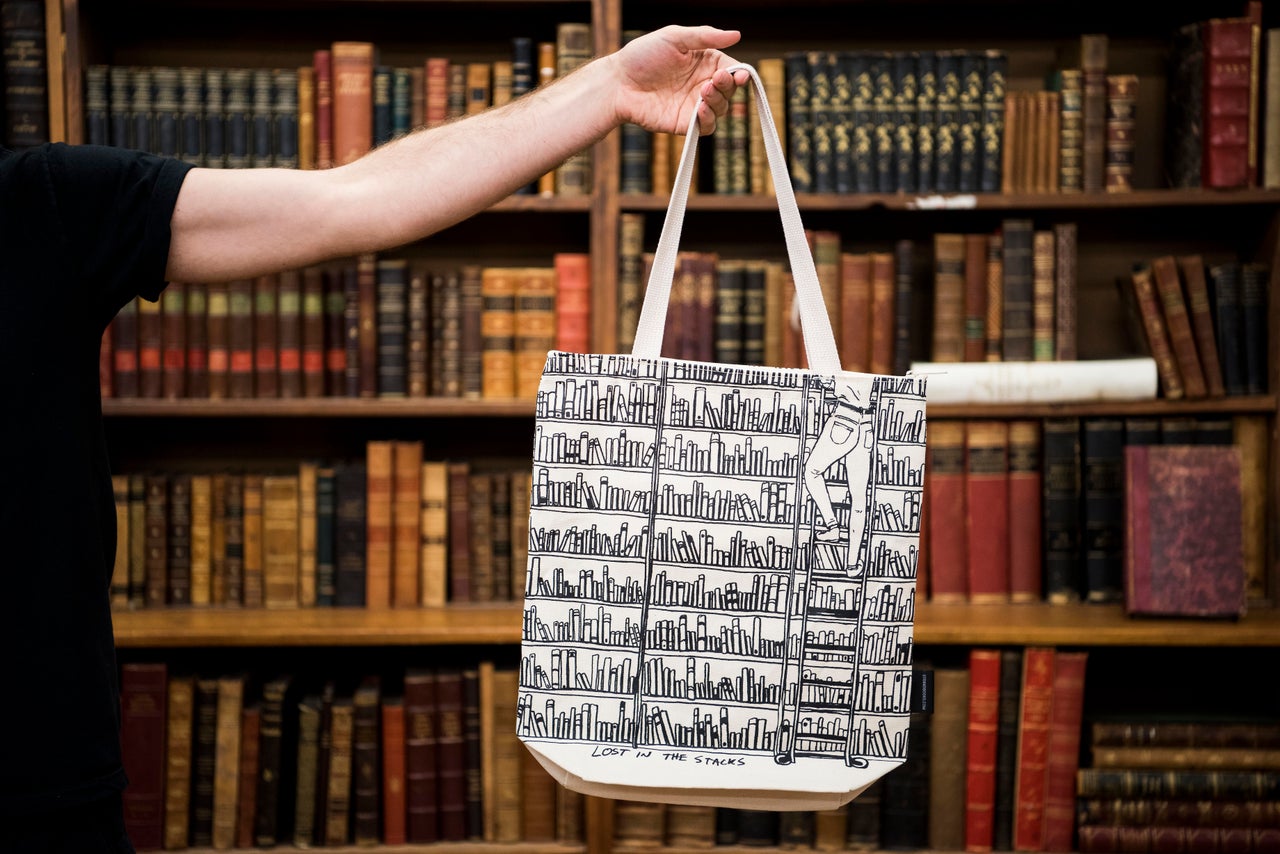
Each tote mentions the Strand’s name in some way, usually showcasing that same red oval logo. (The Strand merchandizing team briefly tried a few other designs, replacing the “miles of books” slogan with the phrase “Where books are loved,” but ultimately went back to the original.)
Nearly 50 of the designs are credited to MacDonald, who began working out on the art department floor around five years ago. His handiwork ranges from delicate, multicolor illustrations of New Yorkers going about their day to an image of an extensively detailed library with ceiling-high bookshelves and cats around each turn.
MacDonald says the idea of a “weird, introvert fantasy world” inspired one of his latest designs: a dusty shelf stocked with a compass, a bell jar, a skull, books and other oddities, all presided over by a black cat. “Stay Curious,” it reads.
Ultimately, the designs come out of a collaborative process, with Bass Wyden and other staff members contributing ideas to a department called Studio Strand, which also consists of designers Greg Locke and Alison George and manager Meagan Henry. MacDonald, who hand-draws designs on a tablet, said that the collaboration can lead to little visual “Easter eggs” on the totes. MacDonald included his dog in a tableau of the city’s canine population. On another bag, the Japanese character for “book” takes the place of the “A” in “Strand” — another fun wink for those in the know.
At first glance, the store’s “Victorian Reader” seems to depict a straightforward scene of old-timey New York, with older building facades, horse-drawn carriages and people in the street with their noses in books.
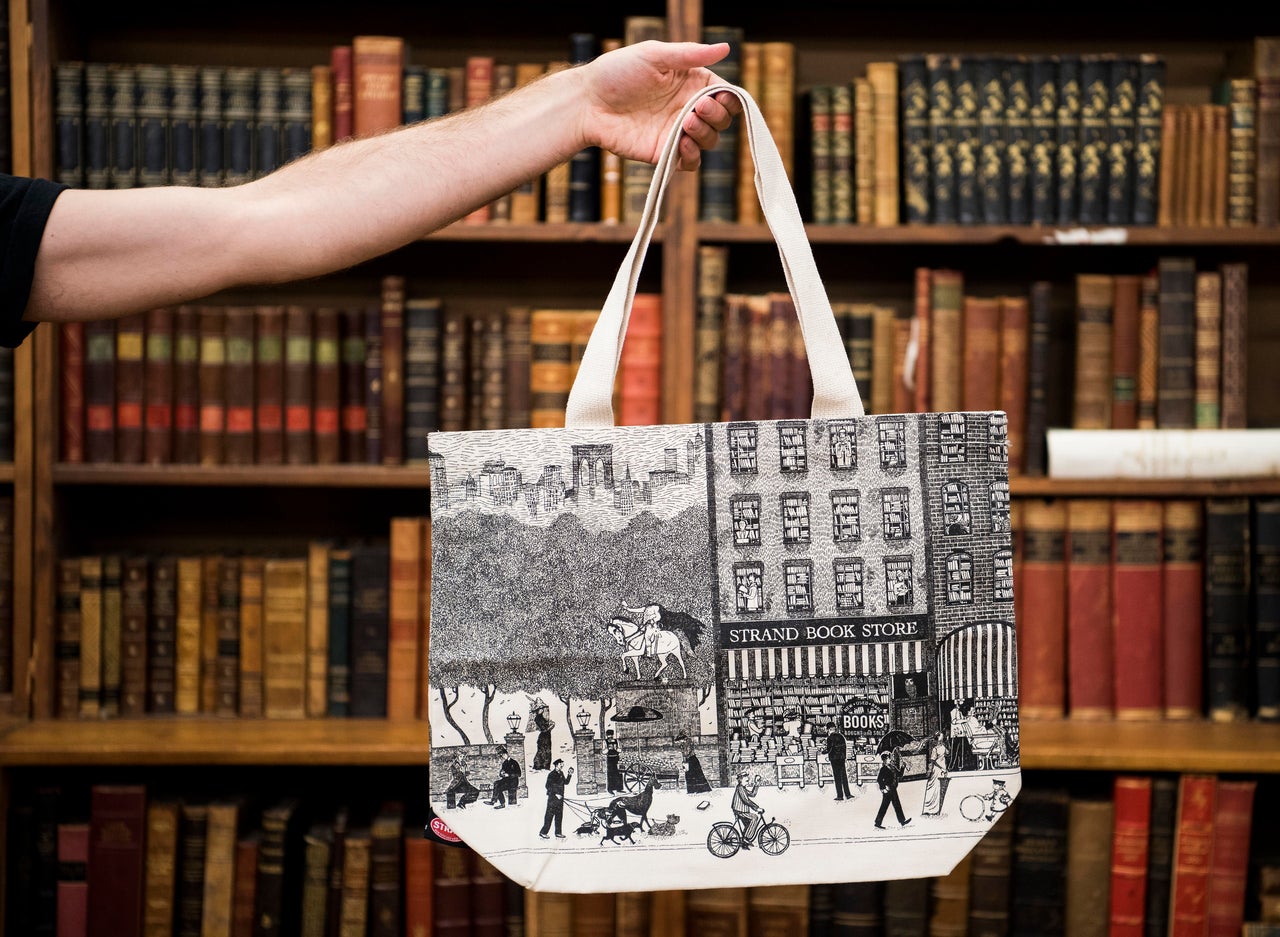
Upon closer inspection, the attention to detail — creepy detail ― emerges. There’s a Headless Horseman statue and a violent barber inspired by Sweeney Todd. A carriage is being driven by a skeleton. Two identical twins ride eerily by on a tandem bicycle.
“I think [Bass Wyden was] just like, ‘Wouldn’t it be creepy if there were some abandoned shoes in the street?’” MacDonald recalled.
“It’s fun to create these opportunities for everyone. Like, what happens if you put a cobweb over here, or what happens if you put, like, a skull at the top of a building?” he continued. “Just making it as immersive as possible.”
Elsewhere in the design, a frustrated writer tosses his papers out the window. In another window, Bass Wyden’s grandfather peers out at the scene below. The design has been in the merchandise rotation for several years.
“It really is all of that detail that really makes it, you know, resonate for so long,” MacDonald added.
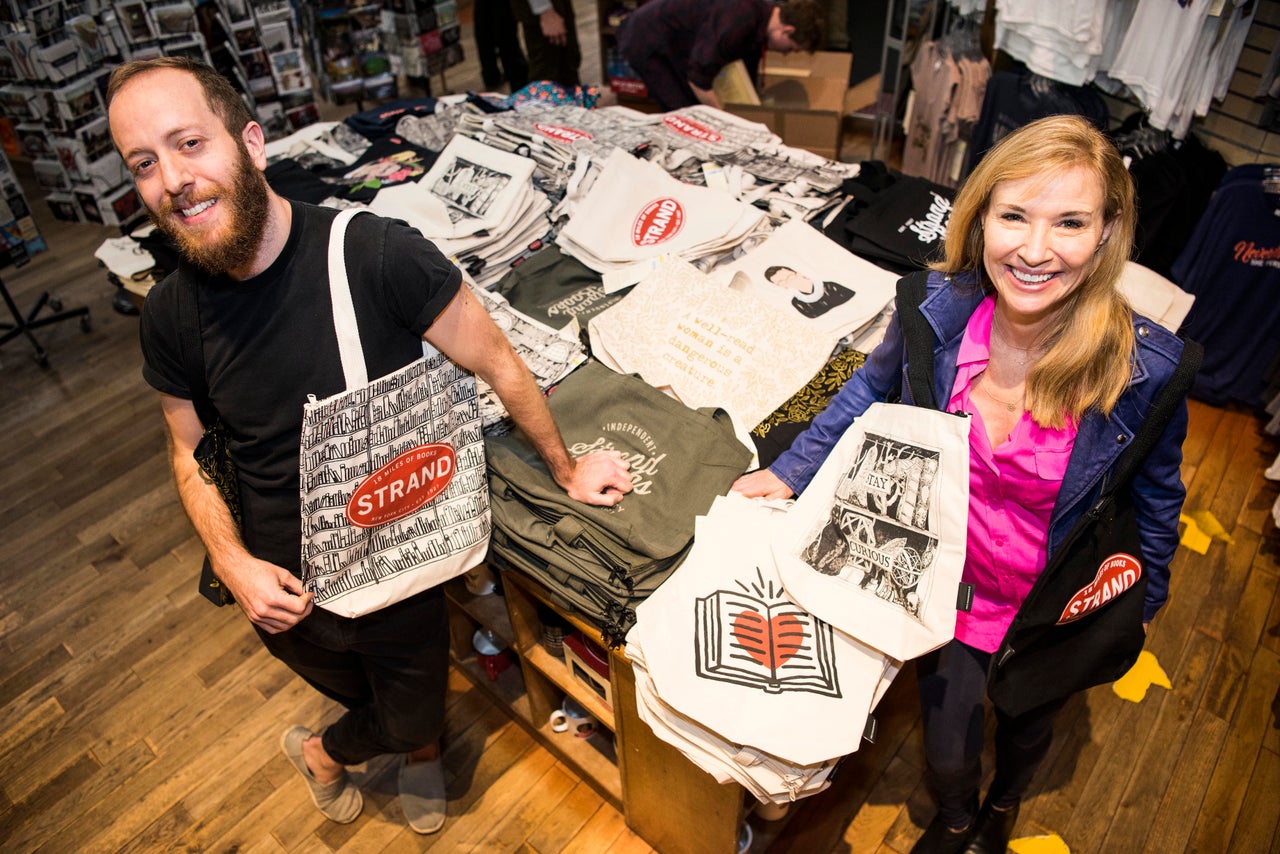
With an in-house design team, the bookstore can also adapt quickly to emerging trends and new catchphrases. When “Hamilton” was selling out nightly, a “Young, Scrappy and Hungry” bag popped up on shelves. When the coloring book craze seized bookstores around 2014, Strand answered with a tote featuring outlines of New York staples: a pigeon, the MetroCard.
The bookstore also offered “F**k 2016” pins and “Make America Read Again” totes: bold statements in a bold election year that allowed people to wear not just their love of reading, but their frustration, on their sleeves.
“I kept saying, ‘Don’t order too much! He’s not gonna be around!’” Bass Wyden said with a laugh, referring, of course, to now-President Donald Trump. The resistance is alive, well and for sale at the bookstore, where Ruth Bader Ginsburg totes lie on a table near others that read, “Nevertheless, She Persisted.”
A tote with the saying “A well-read woman is a dangerous creature” features what looks like a straightforward floral motif against black canvas, but upon further inspection, there are bees sprinkled throughout ― subtly underscoring the “dangerous creature” note. Other totes are collaborations with beloved artists like Art Spiegelman and Adrian Tomine.
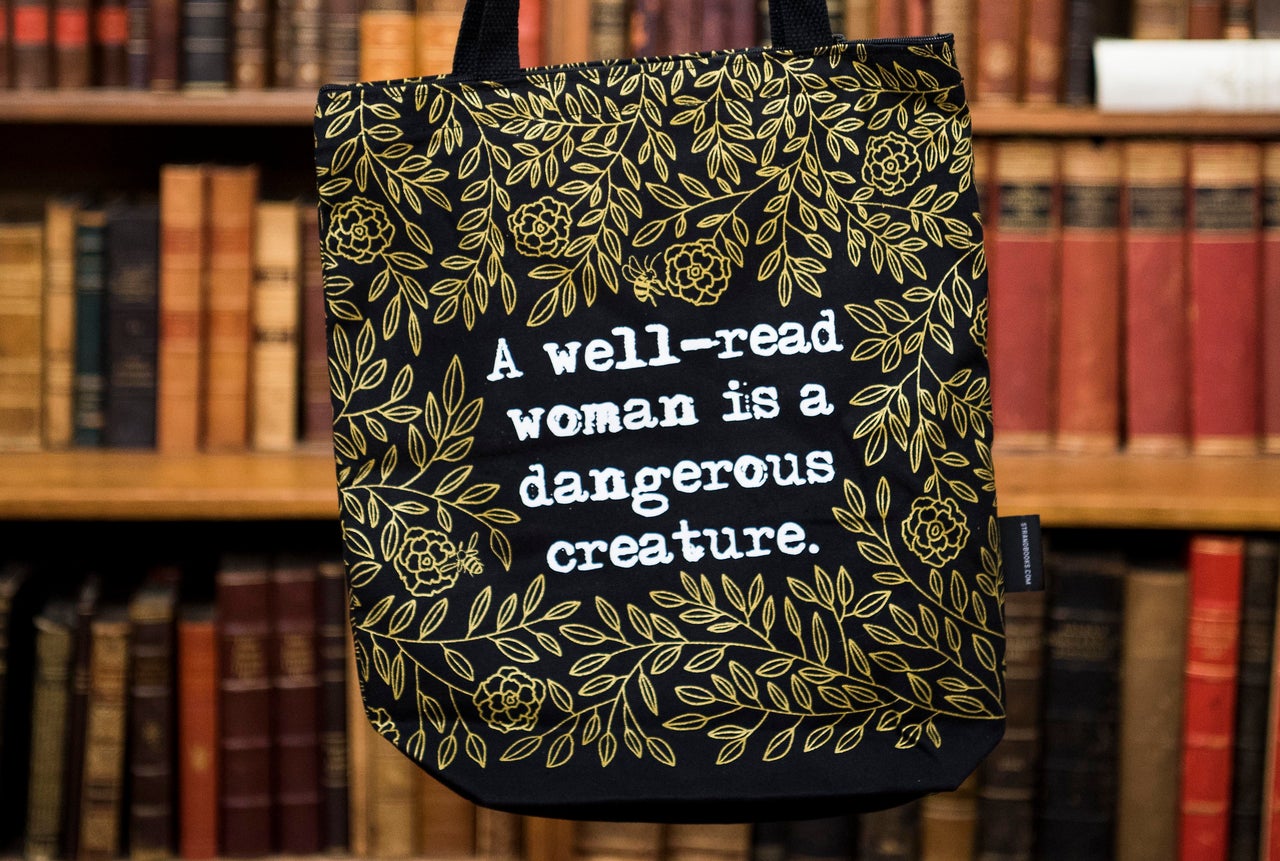
Other designs have come from happenstance. Bass Wyden said a manager who collected autographs and drawings asked painter David Hockney to draw him a picture when he visited the store in the ’70s. Hockney drew a bag of books, which eventually became a tote.
“I thought that was funny, to put a tote on a tote,” Bass Wyden said.
For bookstore purists, the growth of the Strand’s in-store merchandise ― increasingly catering to an in-and-out kind of customer rather than one content to spend hours among the stacks ― might seem at odds with the store’s history as a haven for literature and those who love it. It’s understandable that seeing space occupied by bags advertising the store’s lengthy selection of books, instead of the books themselves, could chafe a certain kind of reader.
But if a bookstore must diversify its offerings to offset changing publishing trends or to reflect customer tastes, the creations tailored for bibliophiles at the Strand seem like a practical, and charming, way to meet in the middle. In a way, the many canvas bags on offer echo the varied customers drawn to the store in order to peruse its curated tables and outdoor carts — creative, singular, true New York originals.
[ad_2]
Source link
[ad_1]
Last month, NASA welcomed Richard Danne to its headquarters in Washington to celebrate work he had done nearly half a century ago.
Mr. Danne never studied the stars. He never built a rocket.
But he and his design partner, Bruce Blackburn, came up with one of the most recognizable elements of the space agency: the logo known as the “worm,” with the acronym N-A-S-A spelled out in bold, sinewy, orange-red letterforms.
The worm endures, even though NASA dumped it more than 30 years ago, returning to “the meatball” — its original logo, with a blue circle, stars, an elliptical orbit trail and a swoosh representing an airplane wing.
In the past few years the worm’s clean, futuristic look has experienced a renaissance inside and outside the space agency; it is now prominently splayed on the sides of spacecraft, T-shirts, sneakers and souvenirs.
This summer it became three-dimensional, a massive sculpture in front of NASA headquarters and a picturesque background for tourist snapshots.
“I love being part of pop culture,” said Mr. Danne, 89.
Look at some of NASA’s recent spacecraft, like the Orion capsule that went around the moon last year, and you’ll see an unexpected mash-up of the two logos.
“Some might say they come from different planets,” David Rager, NASA’s creative director, said during the event that celebrated Mr. Danne and the worm last month.
For half a century, it was one logo or the other at the space agency. NASA started using the meatball in 1959, a year after its founding. It was the logo on Neil Armstrong’s spacesuit when he stepped on the moon in 1969.
The worm is a child of the 70s.
A small, newly formed design firm, Danne & Blackburn, won a contract from the National Endowment for the Arts when that body was seeking to give federal agencies a visual remake. Mr. Blackburn, who had designed the symbol used to mark America’s bicentennial celebration, played with various pictorial approaches, but settled on a futuristic take on the four letters of NASA. The two As, prominently lacking crossbars, suggested rocket noses, or engine nozzles.
“It was extremely simple,” Mr. Blackburn said in 2015. (He died in 2021.) “It was direct.”
The work delivered to NASA by Mr. Danne and Mr. Blackburn went far beyond just a four-letter logo. They also put together a compendium of dos and don’ts — the proper size and usage of the logo, placement of any accompanying text, the specific shade of red. The graphics standards manual sought to give a cohesive appearance across the agency and its centers around the country.
“This is something that didn’t exist prior to our redesign,” Mr. Danne said. “The publications and forms were quite a mess, radically uneven in both language and appearance.”
Mr. Danne said much of the work was devoted to the visual decluttering of the NASA organization. They rewrote NASA’s forms to make them shorter and clearer, and those shorter forms saved on printing costs. They specified standardized layouts, with limited combinations of fonts, which allowed NASA to put out publications more quickly.
“The fact that it looked better was kind of frosting on the cake,” Mr. Danne said during the panel discussion.
Still, many NASA employees disliked the worm intensely, and felt that the meatball, representing the triumphs of the Apollo program, had been thrown away and replaced with something sterile and soulless.
After the loss of the Challenger space shuttle and its crew of seven in 1986, and early problems with the Hubble Space Telescope and its out-of-focus mirror, morale at NASA suffered.
In 1992, Daniel S. Goldin, appointed as NASA administrator by President George H.W. Bush, sought to rekindle the excitement of NASA’s early days and announced the return of the meatball. His farewell to the worm was not unlike the soliloquy of a movie villain about to dispatch the hero.
“Slowly it will die,” Mr. Goldin said to an applauding audience at NASA’s Langley Research Center in Virginia, “and never be seen again.” (The headline in the South Florida Sun Sentinel: “Worm Turns: NASA Junks Despised Logo.”)
Except the worm never completely went away.
People like Michael Bierut, a partner in the design firm Pentagram, lamented the loss. “The worm is a great-looking word mark and looked fantastic on the spacecraft,” Mr. Bierut told The New York Times Magazine in 2009. “By any objective measure, the worm was and is absolutely appropriate, and the meatball was and is an amateurish mess.”
In 2015, Hamish Smyth and Jesse Reed, two designers then at Mr. Bierut’s firm, used a crowdfunding effort to bring the graphics standards manual that Mr. Danne and Mr. Blackburn had created for NASA 40 years earlier back into print. The document is now in its seventh printing, and more than 35,000 copies have been sold.
A couple of years later, in 2017, Coach approached NASA, hoping to put out a collection of NASA-themed jackets, sneakers and bags, and they wanted to use the worm too. “I went back to our legal office,” said Bert Ulrich, the entertainment and branding liaison at NASA, “and they said, ‘Well, maybe you can use it in a vintage sort of way.’ And so then we started permitting it again.”
That’s when the worm started popping up on T-shirts again.
In 2020, NASA sent the worm back into space — on the SpaceX Falcon 9, the first American rocket to take astronauts into orbit since the retirement of the space shuttles.
Just as Mr. Goldin thought the return of the meatball would excite NASA employees who wanted to recapture the glory days of Apollo, the NASA administrator in 2020, Jim Bridenstine, thought the return of the worm would be inspiring to those who, like him, grew up with it as the NASA logo. “I’ve always been kind of partial to it,” Mr. Bridenstine said then.
Now the worm is back. And the meatball is still there too, still the official insignia for NASA.
The agency put together a committee, including Mr. Danne and Mr. Rager, then working at NASA’s Jet Propulsion Laboratory in California, to figure out how to use the logos together harmoniously.
The use of the worm remains limited, “a supporting element to our insignia,” Mr. Rager said. “You have to have special approval to use it. We try to use it on applications where it’s big and bold.”
On the Orion spacecraft, the worm appeared prominently, on the adapter ring between the capsule and the service module providing propulsion and power, while a small meatball was painted on the capsule, next to the American flag.
The meatball “feels like a government agency logo that has some weight,” he said. “It lends a really nice authority, and it feels connected to the legacy.”
But the meatball is a complicated graphic with multiple colors, and not easily recognizable at a distance. “The worm is kind of the opposite of that,” Mr. Rager said. “So those two things kind of balance each other out.”
Mr. Bierut, one of the participants on the panel discussion last month, has warmed up to the meatball a bit. “If you Google me and this subject, you’ll find me saying that the meatball is a terrible, terrible, terrible logo,” he said. “And I have revised my thinking about it since then.”
The meatball was the product of a culture similar to that of the armed forces. “So the idea, that the insignia, as a patch, represents kind of an allegiance to you, your colleagues, and to the mission you’re serving, is really important,” Mr. Bierut said.
Mr. Danne still doesn’t love the meatball, but he is proud of the worm’s return and content with the coexistence of the two logos. “They’re so different,” he said. “We found a way to make it work. Is it ideal? Probably not. But it’s pretty close to being good. And it satisfied everybody, so I can’t argue with that.”
Mr. Rager said people at NASA used to fall into two camps: meatball vs. worm.
“Since we reintroduced the worm, I have not heard that,” he said. “In fact, now that that division isn’t a thing as much, people are appreciating both.”
Photographs from the NASA archives and “The Worm,” a monograph published by The Standards Manual, 2020.
Produced by Antonio de Luca and Matt McCann.
[ad_2]
Source link
[ad_1]
A contemporary reinterpretation of traditional Egyptian architecture, the Mamluki Lancet Mosque by Babnimnim Design Studio poses a spiritual sanctuary for the local community in Al-Masayel, Kuwait. The architects draw on classic Islamic motifs, including calligraphy relief, intricate geometric ornamentation, archways, and the Moqarnas typology to balance a large half dome over the rectilinear space. The mosque unfolds as a sequence of five stone masses, stacked and rotating, each resonating with the five daily prayers and symbolizing the foundation of faith, alignment to the Qibla (prayer direction towards Makkah), and connection to the surroundings. Meanwhile, three intervening masses dynamically coalesce to form a funnel-like configuration, creating an unobstructed interior devoid of columns, facilitating unhindered alignment for prayers.
image by Mohammed Ashkanani
The five progressively rotating masses ascend toward the central half dome which is marked by the symbolic Islamic moon, engraved in intricate metalwork that is echoed in the minaret to signify unity and connection to the divine. A strategically positioned additional mass completes the Islamic Star plan when viewed from above, enhancing the mosque’s identity and visibility in the neighborhood while demarcating alternative side entrances. Babnimnim Design Studio punctuates the facade with minimalist lancet cutouts — motifs and proportions found in classical Mamluki Mosques — that frame windows and structural elements at various levels. A grand wooden door invites worshippers into the sacred space, echoing the half dome that defines the mosque’s core by an elongated form to envelop and house the primary lobby gateway towards the main interior.
The Kuwaiti architects have arranged adjacent smaller half domes in a stepped configuration to serve as luminous wells, infusing natural light within and marking an inviting prelude to the women’s quarters. A stately minaret stands tall and aligns with the central axis, descending within to mark the indoor Mihrab area. It unites the exterior and interior elements, inviting worshippers to focus their devotion towards the Qibla.
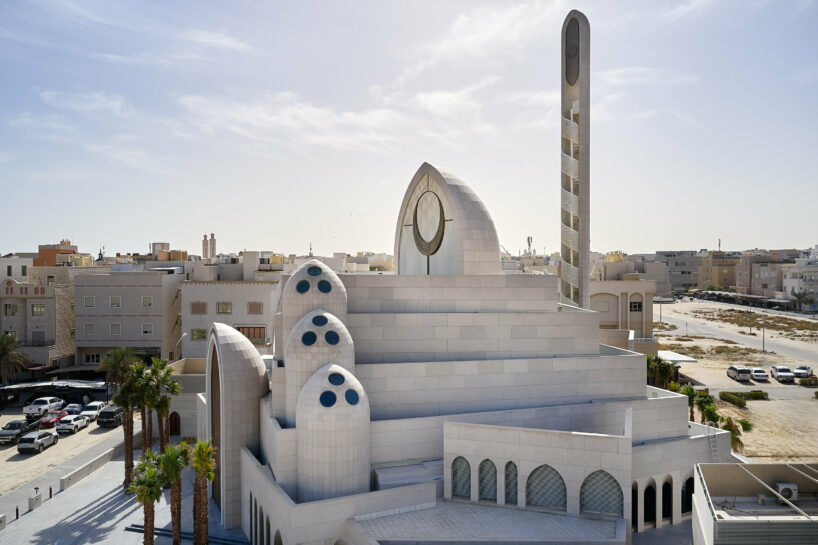
image by Mohammed Ashkanani
Stepping inside the Mamluk Lancet Mosque, a dynamic interplay of masses and finishes marked with juxtaposing ornamentation and simplicity define the space. Lower masses are enveloped in stone for stability while upper masses rendered in pure white evoke lightness and movement. Thuluth-style Quranic inscriptions adorn walls and partitions in calligraphic strokes in a modern relief effect, illuminated by ethereal rays penetrating through rotating volumes. An adaptable sliding partition separates the male prayer hall from the women’s area for daily use, expanding during Ramadan to support larger congregations to maintain inclusivity and unity.
Inspired by the historic era of the Mamluk Empire, the mosque embraces a modern material palette through gray stone cladding and white clay plastering for a subdued yet genuine reinterpretation. The harmonious cool grays and whites, complemented by subtle brass accents, enrobe both the interior and exterior and bridge the gap between past and present, lending a graceful air of timelessness to the architecture.

image by Mohammed Ashkanani

image by Mohammed Ashkanani

image by Mohammed Ashkanani
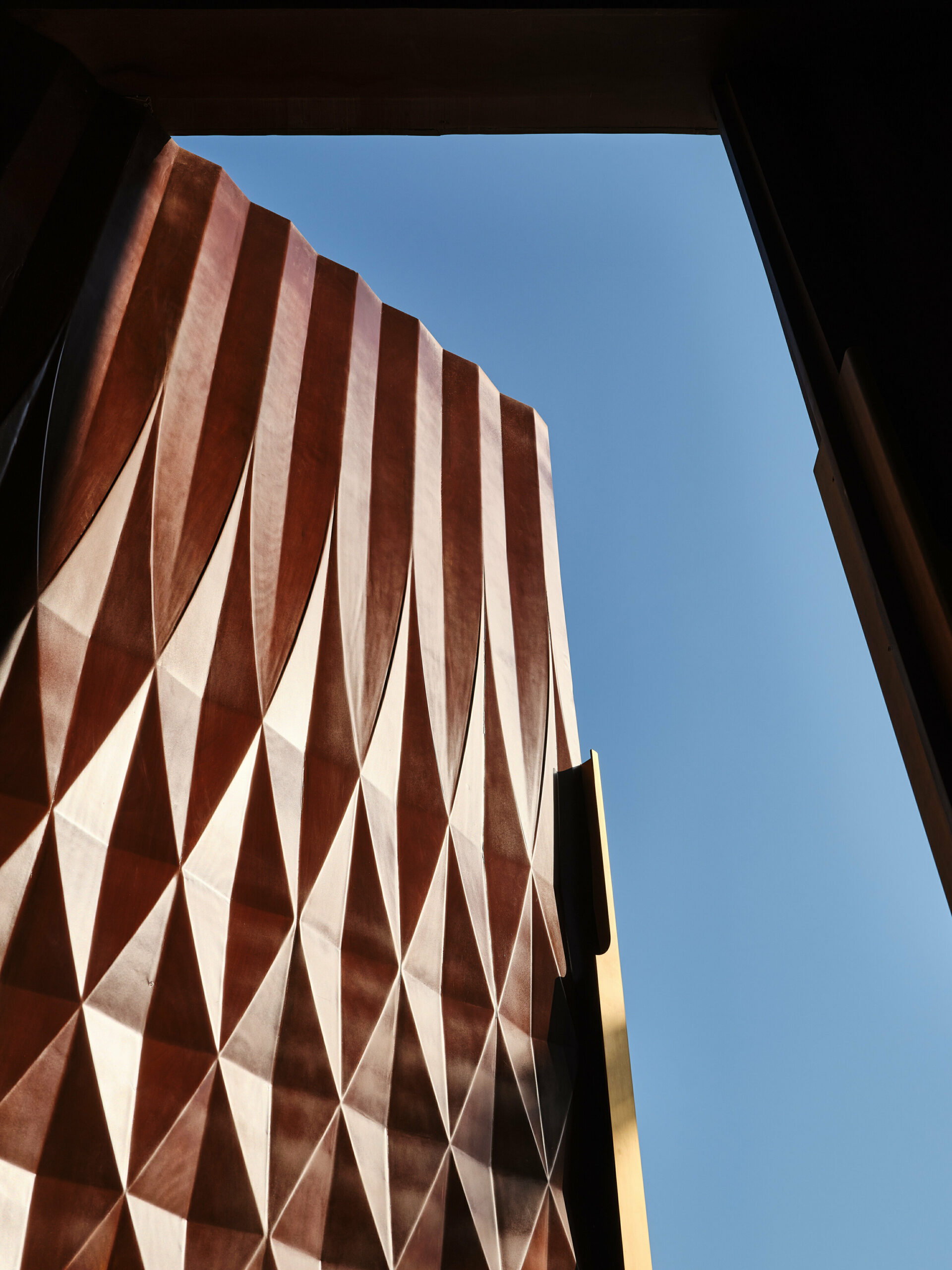
image by Mohammed Alsaad, Nasser Alomairi

image by Mohammed Alsaad, Nasser Alomairi
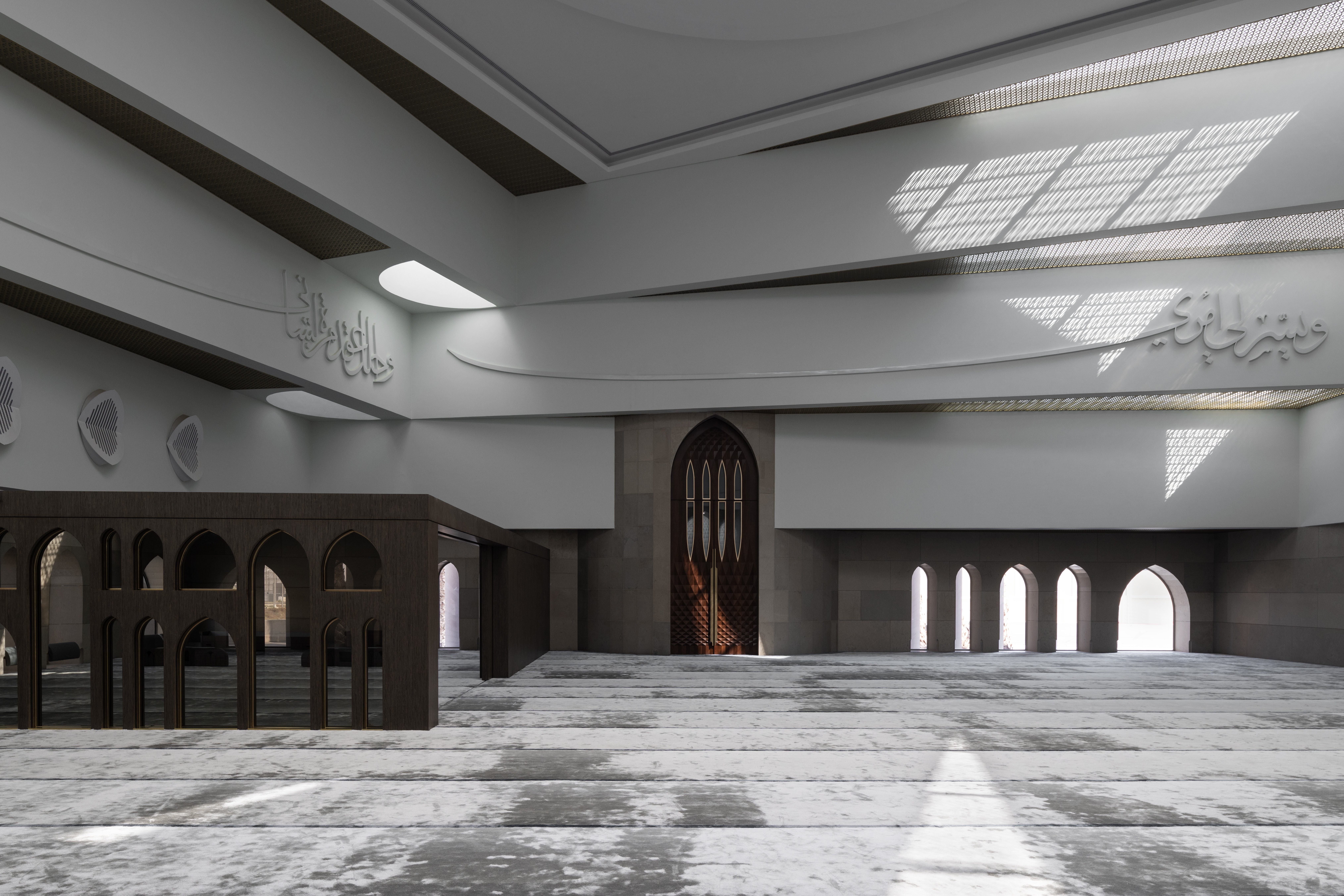
image by Mohammed Alsaad, Nasser Alomairi
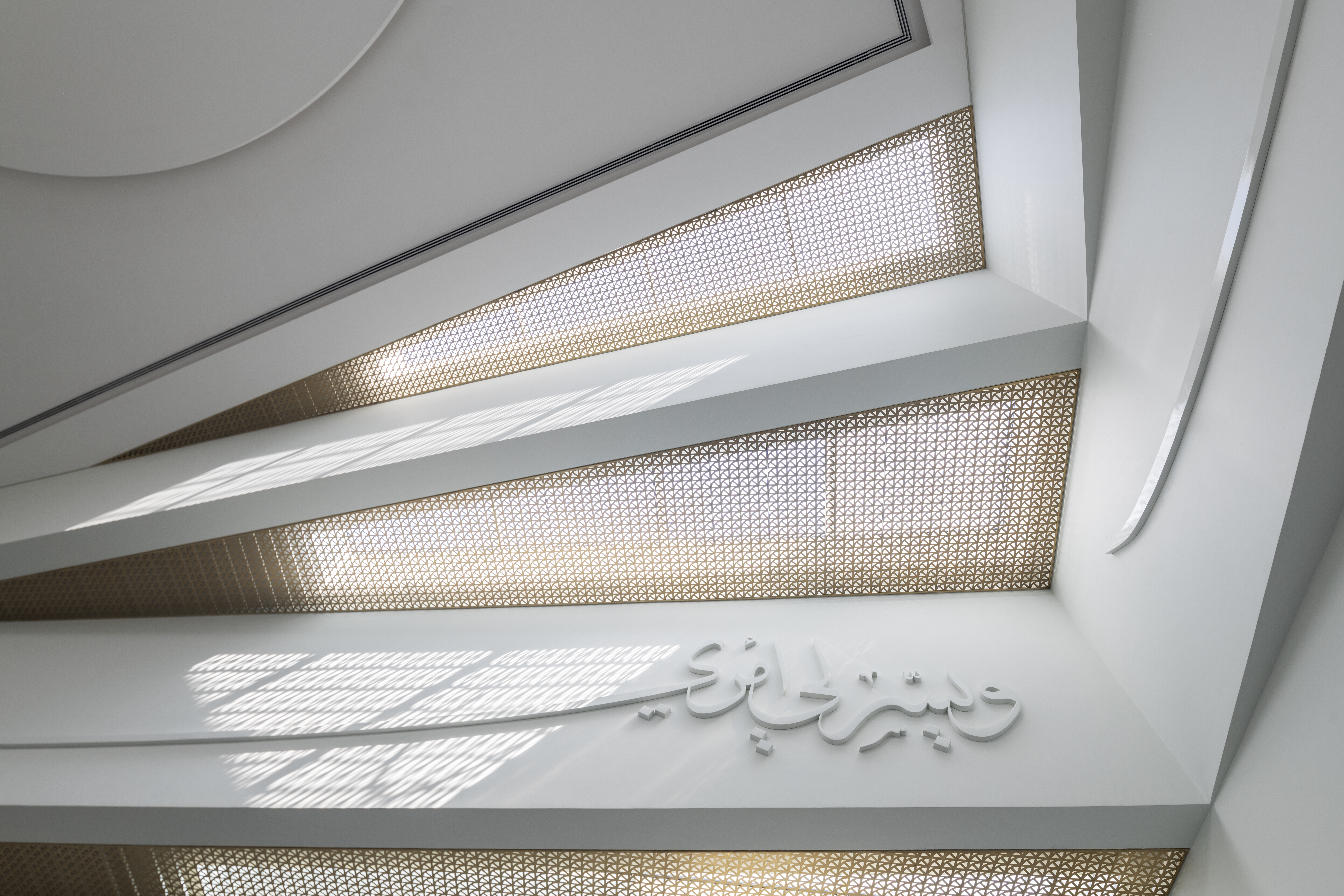
image by Mohammed Alsaad, Nasser Alomairi
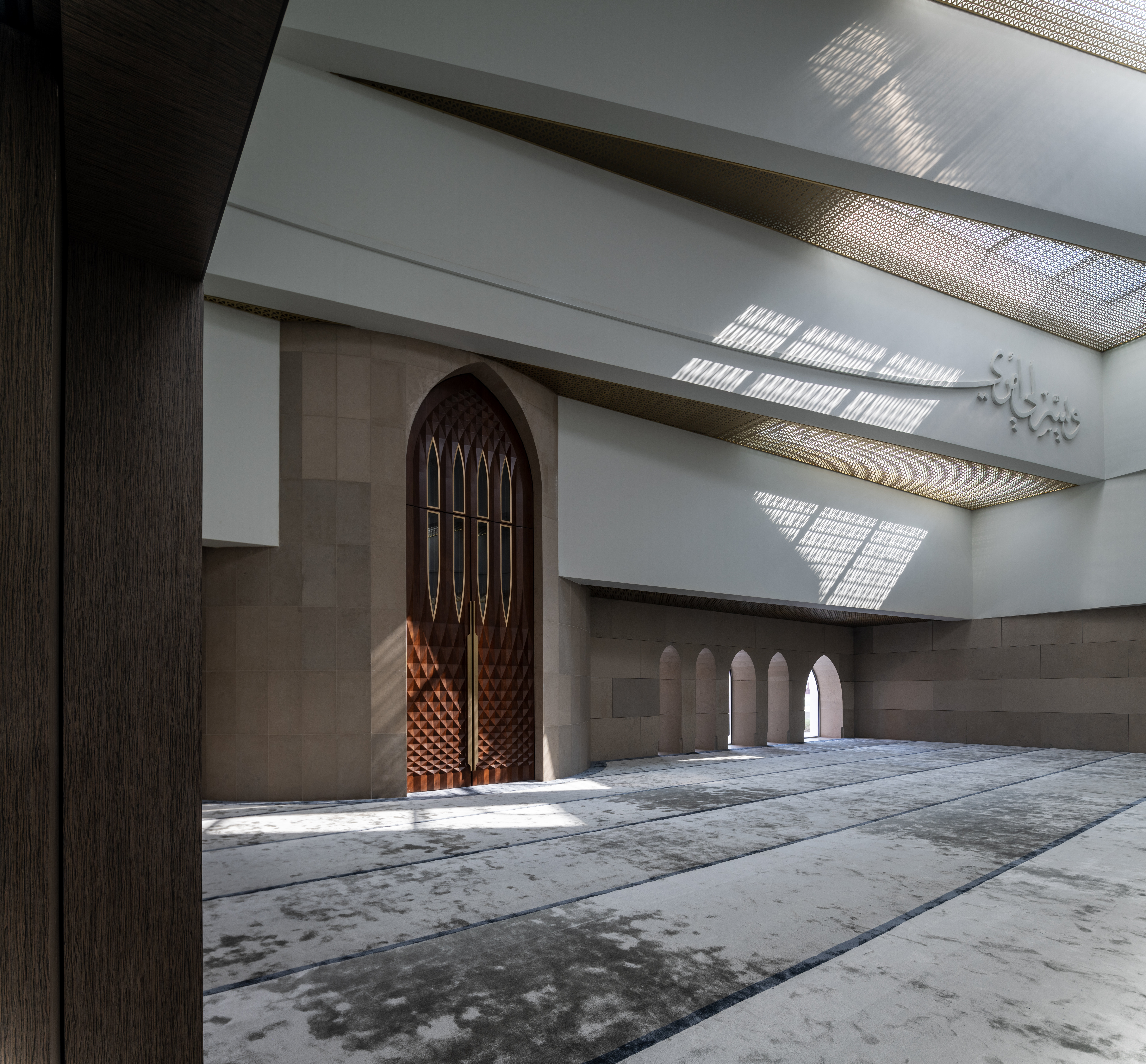
image by Mohammed Alsaad, Nasser Alomairi
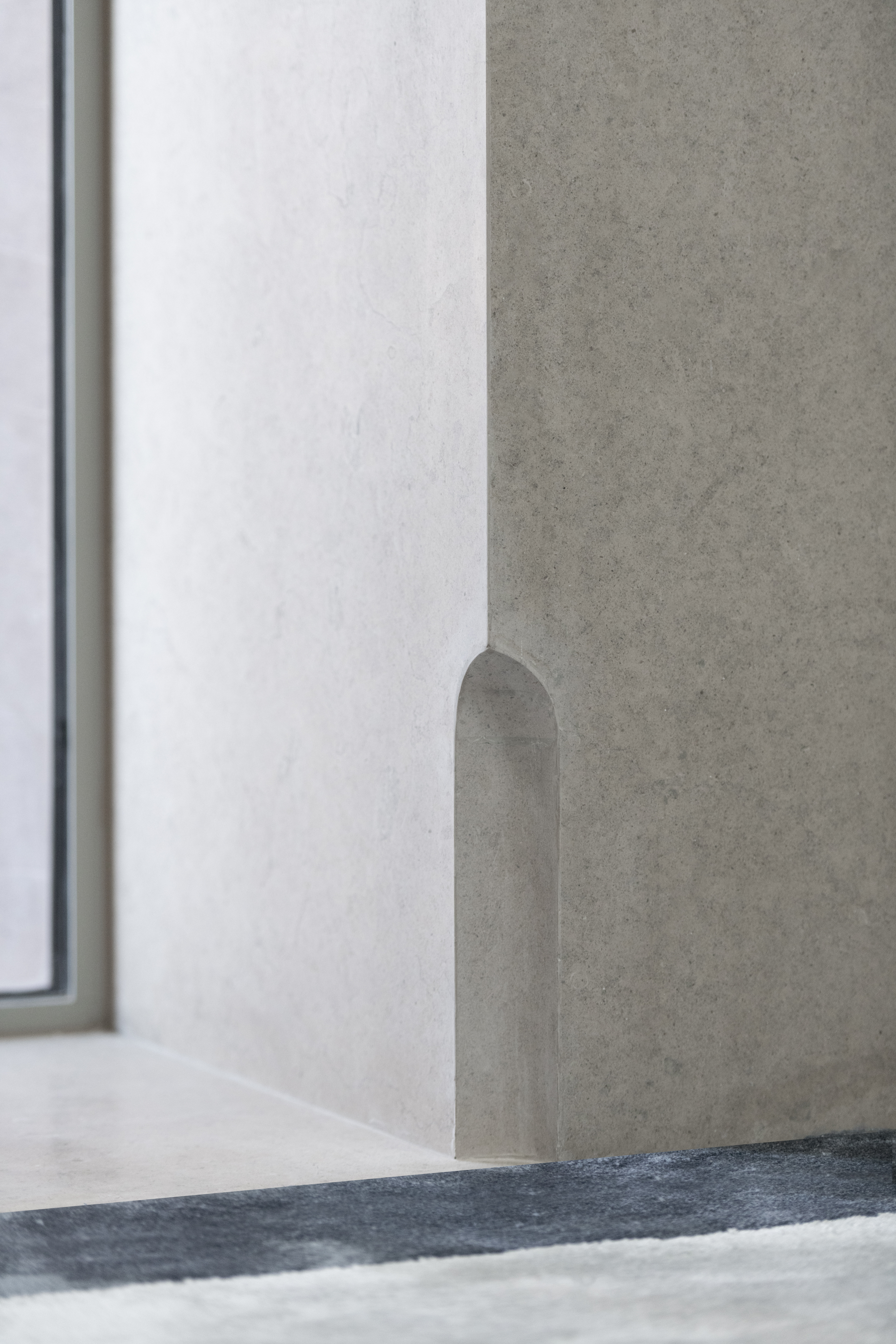
image by Mohammed Alsaad, Nasser Alomairi
[ad_2]
Source link
[ad_1]
The creative use of waste materials is evident in some of the new furniture, such as stools by Normann Copenhagen and Woodmancote Retro. The former is made out of recycled household and industrial plastic, while the latter is crafted from reclaimed hardwoods, locally grown wood, and 100% recycled cosmetic bottles. Floor rugs, also by Normann Copenhagen, are made from recycled PET bottles, and coffee tables have been created from reclaimed pallets. Alternatively, the selected furniture features environmentally friendly, low-carbon materials like recycled upholstery, certified timber, and wood derived from carbon-sequestering forestry. Throughout the space, these new pieces are mixed with reclaimed fittings and furniture sourced either from the site, external reclamation yards, or even a school in Norfolk.
This multi-pronged approach has resulted in a dramatic reduction in embodied carbon – according to calculations by the architects, the project boasts a saving of 1,150 tonnes of carbon compared to a typical office fit-out – and has also introduced a new aesthetic and material language in response to the climate emergency.
[ad_2]
Source link
[ad_1]
Anand Sheth is the man creating a sense of discovery through the design process at Studio Anand Sheth, which opened its doors in 2021. The San Francisco-based architecture and interiors firm practices holistic design that’s strong in concept and artful in point of view. From arts-driven hospitality spaces to gathering-focused residences to localized workplace environments, Anand’s work is resourceful and inventive, reframing our perspective by focusing on changemaking. The result is that each project adds energy to – and shifts the dynamics of – our every day.
“The architectural process has been a part of my entire life. My dad is a construction manager, and a former engineer, and I was surrounded by dozens of copies of old school blueprints at home,” Anand shared. “One of the tasks that folks in the industry will know well is “clouding changes” on multiple copies of drawings – and that’s something I helped him do when I was a kid. Not sure if that was my “hobby,” but I definitely enjoyed spending time doing it.”
He continued: “Design, as opposed to the process of architecture, came to me in waves afterward. I recall sketching floor plans of homes for my childhood friends based on their personalities – indoor pools for the athletes, an entire floor of guest rooms for the social ones, etc. As a teenager, I observed the diverse built environment between South LA and the beach cities. And my career in design formally began after I graduated high school and moved to San Francisco to study architecture.”
Anand’s process is cohesive and very communicative, beginning with hand sketches, architectural drawings, and diagrammatic design representations. These phases work together to establish the intent of each project and fuel it to the finish line. It’s through a clarified aesthetic vision and what his clients value individually that allows the individual narratives to emerge.
That narrative is hugely important to Anand, and leads to what he might do professionally in a parallel life. “I would be a writer. I like to see my architectural work as narrative-rich, and I’m often searching for the “story” behind the spaces and objects I encounter. But there’s something very satisfying about literal storytelling. It’s hard work, and I hope I get there one day, to achieve a direct connection with the reader.”
Anand has created numerous hospitality spaces, including Bar Part Time, Hi Felicia, Sluts the Wine Bar, and Popi’s Oysterette, and several private residences in the Bay Area and Los Angeles. Throughout his career, Anand has strived to balance architecture with service, having served as the Design Lead for GROUND, the non-profit urban platform for activating formerly vacant lots and buildings to restore Black use, an artist-in-residence with Ruth Asawa School of the Arts, and a mentor through CCA and NOMA’s Project Pipeline.
We’re happy to have Anand Sheth join us for today’s Friday Five!
I’m uncharacteristically satisfied, and mildly obsessed, with “La Folie,” a gathering structure designed by Tarek Shamma in Melides, Portugal, for his client Christian Louboutin. It’s inspired by dozens of art and cultural themes including James Turrell, Rajasthani stepwells, the Jantar Mantar observatory in Jaipur, Carlo Scarpa, and more. Perhaps my favorite aspect is the radically honest name, La Folie, or The Folly, “because it’s just for fun.”
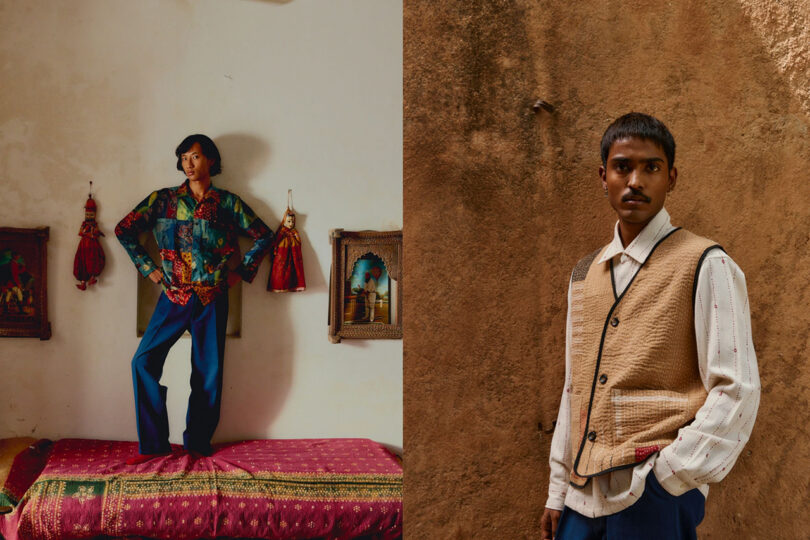
Photo courtesy Karu Research
Emily Bode popularized eastern embroideries in contemporary western menswear, and deserves credit for that, but it’s abundantly clear that she’s tapped into a craft that is centuries old, sacred, and not coincidentally ancestral to her Indian-American spouse. I’m thrilled to see how many South Asian fashion companies are coming online in recent years, focusing on intricate narrative-rich embroidery that transcends boundaries. Fashion brands like Karu Research, Adish, Aomi, Harago, Two Point Studio, Rastah, Darwaza, Wunderhaus, and Johargram. I’m lucky to own some pieces from this emerging movement of designers and they are some of my favorite things to wear.
I have no idea how or when I stumbled upon the Instagram page for fashion designer Miguel Adrover, but it hasn’t disappointed. The artist’s compelling and confronting self-portraits amaze me – his proportions, age, and fearless costuming are superb. He’s been ahead of his time since he rose to fame in the aughts. Adrover has an urgency to his aesthetic that is impossible to unsee.
Jeff Martin Joinery has recently produced a series of ceramic sculptures featuring an evocative dimensional tile that appears almost soft, like extruded dough. He’s calling everything “sarcophagus“ (table, console, etc.) and I’m impressed by the volumes and colors that seem to pull together architecture, textiles, ceramics, and viennoiserie.

Photo courtesy Mooni
I first discovered Ángela Leyva’s portraits this spring at Salon Acme, the art fair in Mexico City. Their work scares me, honestly. I’m frightened to see beyond the familiar lines and curves of the human face and into the abject psyche, but not necessarily the psyche of the subject – it’s reflecting onto me as if I’m the only one with this visual perspective. I find myself considering what’s hidden in plain sight. It’s a smash hit and I purchased a piece for my San Francisco flat this year.
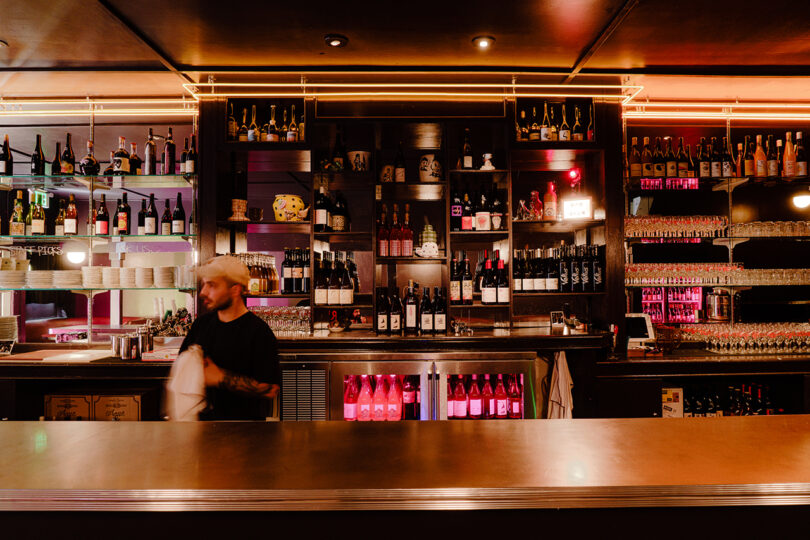
Photo: Ulysses Ortega
Bar Part Time is a visionary wine bar in the Mission District of San Francisco. Three friends and wine nerds ganged together to create something special – a vinyl-driven community dance hall, natural wine dive bar with an eclectic aesthetic honoring all the places and people they love. Together, we took over an abandoned dive bar where we all spent our early 20’s; strategically repairing what worked and replacing what didn’t.
Studio Anand Sheth assembled a team of favorites, including millworker extraordinaire Brandt Hewitt (Medium Small) and go-to hospitality contractor Cookline Construction. We sourced vintage light fixtures from eBay and Stuff (a vintage store around the corner), power-clashed patterns in the flooring and restrooms, and enlisted Meryl Pataky to create the perfectly nostalgic neon pieces above the bar and in the window.
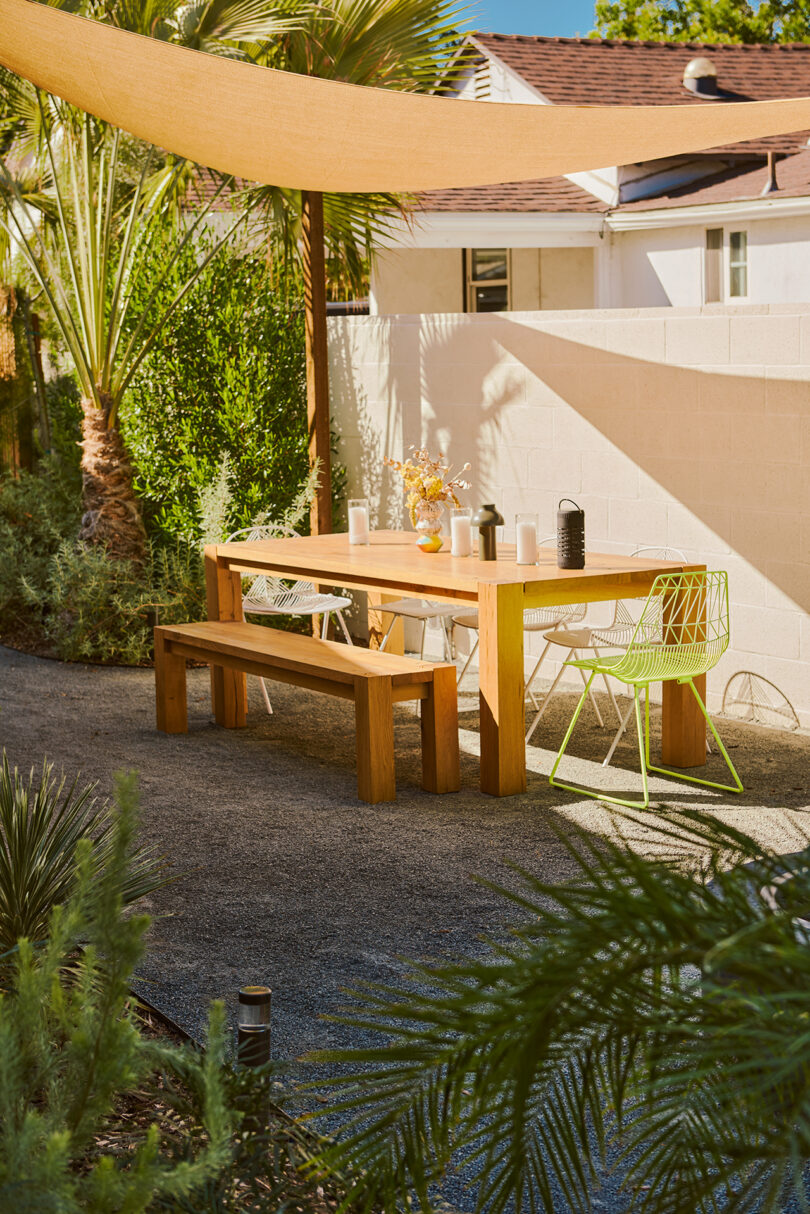
Photo: Michael Irwin
Studio Anand Sheth teamed up with Bay Area-based landscape architect Dune Hai to create a resourceful and color-driven garden as an extension of this Los Angeles couple’s first home. The result is an outdoor living room concept that came to life as if it always existed within the tranquil hills of Eagle Rock.
Inspired by the forms of the Burle Max rooftops in Brazil, they carved curves into linear cedar elements to allow earth and plantings to take up more space. Now, living greens – from Fan Palms to Monkey Flower to Silver Feather Grass – thrive between the outdoor “rooms” for living, dining, warming, and (eventually) soaking.

Photo: Nicholas Ruiz
The firm’s design of Retool’s Mission District headquarters encourages observation, personal connection, and reflection. Consideration of the potential internal happenings inspired the space’s design foundation: a new perspective of “the workplace,” company culture, and – most importantly – its people.
We transformed 72,000 square feet of commercial office space across four floors of a historic industrial building. Careful design decisions tie the four-floor design program together with purpose and ease — art from architectural artists like Rowan Bouroullec, Natascha Madeiski, Sohan Murthy and Tauba Aerbach fill the walls. All conference rooms feature a painted wainscot application using Farrow and Ball colors that coordinate with Maharam Fabrics upholstery. We added accessories like accent pillows, rugs, coasters, planters, and Japanese toolboxes to complete the space.
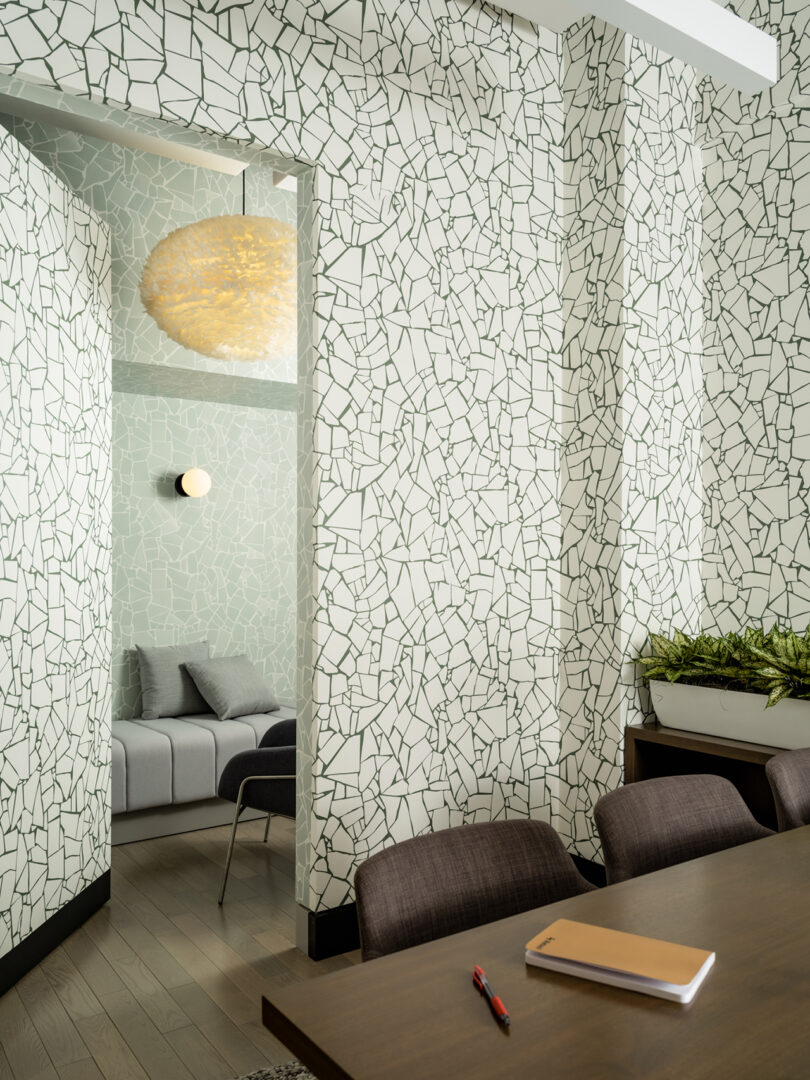
Photo: Joseph Kramm
The New York iteration of Retool’s workplace design features a palette of wall finishes from repeat vendors and Abnormal Anonymous, smartly reused furniture, and strategic lighting upgrades throughout. The firm broke the typical formal office reception in favor of welcoming guests and employees into a working lounge, outfitted with a second custom neon sign by NY-based Ali Feeney over brand-reminiscent wallpaper. The lunchroom and meeting rooms adopted a unique painted wainscot approach, a favorite for accenting spaces with exposed ceilings, and acoustic materials integrated into ceilings, walls, lighting, and custom curtains.
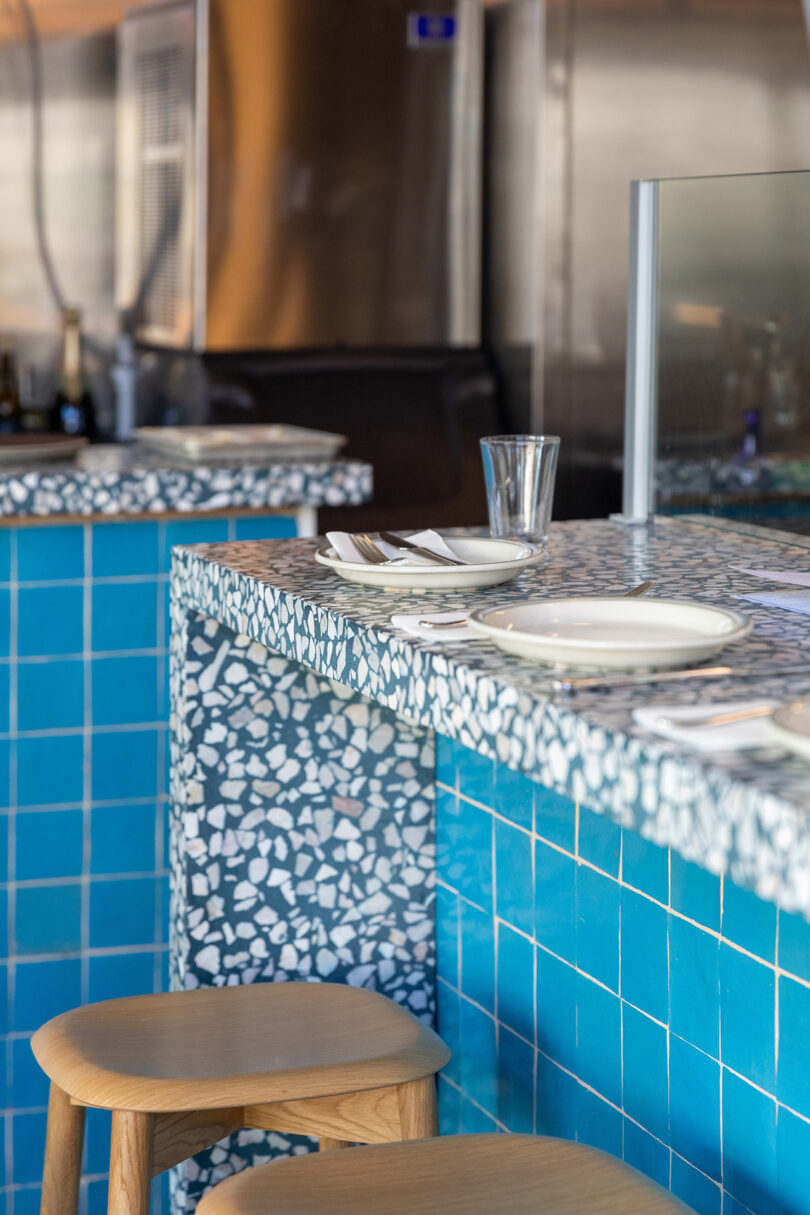
Photo: Nicholas Ruiz
Stepping inside Popi’s Oysterette evokes a family dinner setting that’s right on the Northern California coastline – think crashing waves, shimmering reflected daylight, twilight, and sandy boulders traversed in dress shoes. Founders of the popular Tacolicious restaurants spun off to create a jewel-box seafood restaurant for Top Chef alum and local “Seafood Queen” Melissa Perfit (Bar Crudo, Sister) – the buzzy corner spot slings the best oysters, seafood, and crisp wines the region has to offer.
Studio Anand Sheth developed a deep and strategic palette of seaside-inspired elements. A custom blue terrazzo by Concrete Collaborative clads dining counters providing a vibrant backdrop to the Oysterette’s offerings, while stacked azure zellige tiles create a grid of natural texture. Sconce lighting from Cedar and Moss are the pearls, too on-the-nose? The restroom is wrapped in Douglas fir panels that reference the exposed ceiling structure and new furnishings, and ceramic tiles from Zia and fluid wallpaper depicting swimmers. Hand-painted signage by Manny Fabregas adorns the exterior and hearkens back to the historic fish markets of the Marina District. The resulting experience is playful, direct, and memorable.
[ad_2]
Source link
[ad_1]
It’s not often you laugh in a contemporary art exhibition, but I did in Jesse Darling’s room at the Turner prize show. There’s an energy and wit to his sculptures, made from crash barriers and red-and-white plastic tape; to his jaunty, priapic candles attached to walls; to his hammers bound up with ribbons and bells and placed in glass cases (their inherent masculinity spoofed and transformed, as if they were fetish objects from some future religion). “This was the most public gig I’m ever going to do in Britain,” he says of the exhibition at the Towner Eastbourne gallery. “I mean, the British public reasonably don’t care about contemporary art, because they’ve got plenty of bad things to deal with, especially at the moment. But the Turner prize does feel a bit like public property, and rightly so. So the whole British thing in this show is quite on the nose. I won’t do it again.”
Darling, 41, lives in Berlin: his observation of the state of Britain is that of someone who has become something of an outsider. He has talked of his shock at coming back to a post-Covid UK that seemed dilapidated and run down. Berlin, with its decent childcare system and welfare support, feels more hospitable. But the exhibition is not only about Britain. It is, more generally, about the impermanence of things; the fragility of what we take for granted. The unusually engaging film produced to accompany the show (such films are an annual part of the Turner prize, usually a dutiful studio interview to contextualise the work) makes that clear.

In this little movie, Darling and his crew roam around coastal England for three days, visiting container ports, pausing to look at messed-up, trash-filled car parks, and picking the blackberries growing in profusion on a roadside. Everything is so beautiful and interesting, he says delightedly at one point. But it’s also decaying and collapsing. “The zombie apocalypse is now. This is it,” he says. Later, half-quoting author William Gibson, he adds: “The apocalypse is already here, it’s just unevenly distributed.”
This mood – a sort of intrigued millenarianism – comes from a deep place. Just over a decade ago, Darling was suffering from serious mental and physical ill health. He became gripped by a fear that the world really was ending. “I wasn’t alone,” he says, mentioning interpretations of Mayan prophecies that the world would end in 2012. Recovery was slow – “I changed my diet and I made myself a rule of no internet after 7pm” – but he gradually got himself steady again.
“I knew intuitively what my body needed to get out of this very vigilant state,” he says. “But I still had to come to terms with the end of the world.” To do so, he read a lot, and came out of it more philosophical: the world is ending right enough, or at least the world we recognise, but on the other hand: “You can say that the colonised indigenous have already experienced the apocalypse, if not several apocalypses. In other words, the world has always been ending for somebody.”
He goes on: “Our empire is coming to an end. But it’s had a good run. The good times are over, but that’s all right. Come on, it could be worse. We’re not in Gaza right now. And maybe there’ll come a time when the forever war comes here as well. And in that case, we’re going to have to take the lick.”
Darling’s route to becoming an artist was far from straightforward. He grew up in Oxford – one of the shows that secured his Turner nomination was a survey of his work at Modern Art Oxford. His childhood there sounds salutary, and has clearly informed his work, which often riffs on ideas about private property and enclosure, as well as colonisation. “The university owns most of the city,” he says, “so you’d be walking by the river and looking for those beautiful dreaming spires. But if you live there, you can’t actually access them. You have to peer over the walls to see them, these beautiful walled gardens. I think it gave me a class politics quite early on.”
He remembers a sort of parochialism, in which boys who had behaved in a certain way at their private schools then blithely made the city their own club, marauding through the streets, taking up space “as if they owned the whole town, the whole world. That’s not true of all of the students who attend Oxford – but these are the people who now run the country.”

As for his time at school, he says: “I have always been something like an artist. I’ve always made things and told stories. It’s been like a compulsion.” Yet becoming an artist didn’t feel like a route open to him. A first try at art college, in Amsterdam, ended in his being “kicked out after a year. I was too young and taking too many drugs.” He worked as a cook for a time and lived in squats: “Living in a sort of ‘city under the city’ where I didn’t pay rent, taxes or anything like that until I was about 27.”
His catalogue of occupations is fairly remarkable. “I was a circus clown. I’ve been a painter-decorator. I’ve been a research assistant. I’ve worked briefly, at different times, in different areas of the sex industry. I’ve worked in retail but I was bad at it. I’ve been a barista and a barman – and I was bad at that too. I’ve been a life model. I’ve been a dancer, working with kids and adults with physical and developmental disabilities. God, you know, I’ve really done a lot of things.” Does he want to say more about the sex work? “No,” he replies. “Let’s just put it there and leave it.”
At the tail end of his 20s, he talked himself into a theatre design course at Central Saint Martins in London – and quickly switched to fine art. “I was in sculpture and had no idea what the hell was going on. I looked at all these amazingly dressed kids just ‘making work’. I was like, ‘Wow, someone really believed in you, didn’t they?’ And I just had nothing going for me except that I’d had a life – but I was very defensive and tricky.”
after newsletter promotion
Any Turner winner will go home not just with £25,000, but with a fistful of opportunities, often to produce and sell more of the same kind of work that won them the prize. Darling isn’t interested, though. “I don’t think I was really put on this Earth to make luxury objects for a class of people who have nothing in common with me and mine, and who, frankly, have contempt for everything I love. And so I’m like, ‘How can I use my limited skill set, my unemployable psychotic logic, to do something else?’”
He wants to make more films, he says, if he can find people to fund them. And then – and I certainly didn’t see this coming – there’s his idea for a musical. “It’s in the very early stages,” he says, “but we’re thinking to make an end-of-the-pier, pantomime, Punch and Judy version of Our Lady of the Flowers” – referring to Jean Genet’s autobiographical novel of underground queer Parisian life, written in prison in the 1940s.

If that weren’t a cultural handbrake turn enough, the next minute he’s telling me about his love for the Bond movie Skyfall. “It’s sort of James Bond in drag. It’s completely clear in that film that the empire is necrotic and the old man’s past it – he fails his physical and M’s on her way out too. M is Queen Victoria, she’s Britannia, she’s the mother of a nation. She’s also just a ratty old bag and she’s not long for the world.”
Call it psychotic logic, or just an unusually well-tuned sense of the interconnectedness of things, but all of this – Punch and Judy, end-of-the-pier shows, necrotic empires, queerness – is visible in Darling’s work for the Turner prize. He says of the exhibition: “What I’m trying to do is to make visible the fact that all the big stories and big structures that we really believe in are just flimsy and arbitrary. They may all fall down – but that also means things could one day be otherwise. And that for me is hopeful. And funny, as well.”
[ad_2]
Source link
[ad_1]
How does it feel to have your life change in an instant?
Emilie Gossiaux was an art student at the Cooper Union in 2010 when she was hit by an 18-wheel truck while on her bike in Brooklyn. Taken to Bellevue Hospital, she had suffered a traumatic brain injury, a stroke and multiple fractures. While Gossiaux ultimately regained her life, she had lost her sense of sight. She struggled to decide if she could, or even wanted to, continue making art.
“I had to adjust that framework in my head of what it means to be an artist,” said Gossiaux, now 34, who had always viewed her ability to draw and paint as “my absolute superpower.”
From age 4, her favorite thing to do was copy cartoons on television. Growing up in New Orleans, she charged other children 25 cents a head for drawing lessons she would give in the playground at recess. At 5, she began to experience hearing loss, which only heightened her attention to images and facial expressions.
“I just became more hyper-aware of using my vision,” said Gossiaux, who now wears hearing aids. “That was my way of learning and understanding.” She went on to attend magnet high schools for art, where she envisioned a future life as an artist with big museum exhibitions. At the Cooper Union, in her delicate, stylized drawings and sculptures, she favored the figurative and the handmade, using tactile craft materials like plaster and hair.
But after the catastrophic accident that blinded her, Gossiaux had to confront “some inner ableism” that told her she could never work at the same ambitious level or put in 15-hour days as before at the studio. She spent 11 months at a training center called BLIND Incorporated in Minneapolis, learning skills to navigate the world independently, including use of a white cane.
“Once I started to do that alone, I imagined myself in a video game,” she said, “playing to win.”
There, in woodworking shop, she also learned how to translate images in her mind using hand-to-hand, rather than eye-to-hand, coordination.
When sketching, she lays her paper on a rubber pad called a Sensational Blackboard that embosses the lines as she draws with one hand, following along with her other hand to feel the images.
“I’m using one hand to ‘see,’ the other hand to carve or draw or manipulate” the object, explained Gossiaux, who did return to Cooper Union, where she graduated in 2014.
And she learned to listen to her body and recognize the importance of rest, and of bed as a place to freely imagine her ideas. Only then did she feel she could really be an artist again.
“I allowed myself to sort of daydream about the work I wanted to make and not be so rigid,” said Gossiaux, petite and beatific, sitting in her studio at the Queens Museum, where she has been in residence for the last year on a Jerome Foundation Fellowship for Emerging Artists.
This week, Gossiaux’s youthful dream comes to fruition with the opening Wednesday of “Other-Worlding,” her first solo museum exhibition, which runs through April 7. It celebrates her 13-year-old guide dog, London, and their mutual dependency. “I protect her and she protects me,” Gossiaux said. On a more universal scale, her art seems to remove barriers between animals and the rest of the natural world.
The installation consists of three papier-mâché sculptures of hybridized dog-women — versions of London, scaled to Gossiaux’s height of five feet — dancing on their hind legs. They gambol around a maypole, which here is a monumentalized white cane. Fantastical and serene, the Londons hold colorful felt leashes that stream from the top of the 15-foot-tall cane, no longer constrained.
Brightly painted papier-mâché flowers are strewed across the wide circular platform. Trees crowned with a canopy of 600 individually made papier-mâché leaves wrap around the gallery walls like a 3-D collage.
Three whimsical pen and crayon studies hang on a wall, one with iterations of London floating blissfully. “The sheer joy that comes across in her work, it almost bounces off the page,” said Sarah Cho, an assistant curator at the Queens Museum and a member of the jury that selected Gossiaux for the residency from among some 380 applicants. “There’s this vibrational movement in the way that flowers are drawn, the petals just seem to flutter.”
Gossiaux has worked with London, an English Labrador retriever, for 10 years and describes her as both “mischievous and a little bossy.” Their bond strengthened when the artist started graduate school at Yale in 2017, where she felt very alone for what she said was the first time. “London became my constant,” she said. “I was really craving intimacy and closeness.”
She explored their attachment in sculptures included in her Open Call exhibit at The Shed, “True Love Will Find You in the End,” and in the group show “Crip Time” at the Museum für Moderne Kunst in Frankfurt, which acquired two dog-women.
Gossiaux said her ongoing body of work featuring London has been influenced by the writer Donna Haraway, whose feminist theories look at cross-species relationships as a model for breaking down all kinds of hierarchies, whether patriarchal or economic.
“What if we didn’t center the perspective all around humans?” Cho said. “Emilie’s combination of animal and human bodies makes it almost feel like you’re there in this world with them.”
Andrew Leland, whose memoir “The Country of the Blind: A Memoir at the End of Sight” chronicles his experience with gradual visual loss, couldn’t stop thinking about a drawing that he encountered last year in Gossiaux’s exhibition “Significant Otherness” at Mother Gallery in TriBeCa. Leland acquired the piece, “London, Midsummer No. 1” — which the Queens Museum has brought to three-dimensional life — likening its “elegant rudimentariness” to the blithe figures in Matisse’s “Dance.”
“Emotionally, the cane, for me, is the most stigmatized aspect of this highly stigmatized disability — it marks you instantly,” he said. “Emilie really went into the experience of being a blind person in the world and found this image of freedom that is profoundly meaningful to me.”
Gossiaux’s drawing became the springboard for a chapter in Leland’s book about blind people’s relationship with visual culture. “Having somebody like Emilie making work that’s on the international art market pushes back against the image that so many people in 2023 still have of a blind person as fundamentally incompetent,” he said. “Not only do blind people have an interest in visual culture, they’re producing it and moving it forward.”
The artist Finnegan Shannon, who experiences pain walking or standing, invited Gossiaux to contribute to a fantasy of disability access in Shannon’s exhibition “Don’t Mind if I Do,” through Jan. 7 at the Museum of Contemporary Art Cleveland. Gossiaux created 3-D printed ceramics of London’s body parts, including her tongue and a paw, that circulate throughout the room on a conveyor belt with other artists’ works, carried to viewers who can relax on plush seating.
“I really respond to the play in Emilie’s work,” Shannon said, adding that people in mainstream culture tend to talk about disability in somber terms, “always such a funny contrast to my experience as a disabled person where there’s a lot of humor.”
“I’m really excited about the way Emilie bridges these very specific experiences she has in her day-to-day life,” Shannon said.
Gossiaux’s process always starts with drawing. She pulls from her visual, muscle and tactile memory. “I know what London looks like because I’ve seen Labradors before, but I’m also getting the sense of her body from petting her and playing with her, feeling her face,” said Gossiaux, who always completes a drawing in one burst of energy. “I also draw from my dreams because they are still very vivid.”
When she translates drawings to sculpture, her life partner and studio assistant, Kirby Thomas Kersels, helps her measure and shape the pieces in Styrofoam. Gossiaux layers on papier-mâché and then paints them, using her fingers rather than a paintbrush. “I’ve found ways to make it more of a tactile experience,” she said.
The artist will lead two “touch tours” of her installation at the museum for blind and low-vision visitors on Jan. 21 and April 7. “I think of touch as a love language; it’s very intimate,” said Gossiaux, who worked as an educator at the Metropolitan Museum giving tours to visually impaired audiences for five years before the pandemic.
Gossiaux’s ability to verbally describe works has helped Cho, the curator, write better audio descriptions herself. (Kersels, who lives with Gossiaux and London, said he was first smitten with the artist when he dropped in on a class at Yale and heard her present a student’s sculpture.)
Gossiaux’s day-to-day presence in Queens has helped move the needle on the museum’s efforts to increase accessibility. To facilitate Gossiaux’s freedom of movement, the staff installed raised tactile lines on the floors throughout the office and studio spaces, and Braille on kitchen surfaces. In the galleries, it is now offering audio descriptions for every artwork.
The artist and research professor Liza Sylvestre, who is deaf and was also included in the Frankfurt exhibition “Crip Time,” said that the Queens Museum has likely learned much from Gossiaux’s residency. “A lot of focus at museums has been placed on accessibility programs and maybe less on support of artists with disabilities and their particular way of moving through the world,” Sylvestre said.
Gossiaux considers herself an activist for disability justice, pointing out that for the first time in her work she has included the white cane, a tool of her own independence. “Being out in the world with my white cane, or with London, that would get in people’s way and annoy people,” she said. “But I feel like they’re denying my right to be there or to even exist.
“I want the white cane to be in people’s way,” she added, with gentle forcefulness. “I want it to take over the space.”
Emilie L. Gossiaux: Other-Worlding
Dec. 6 through April 7, Queens Museum, New York City Building, Flushing Meadows Corona Park, Queens, (718) 592-9700; queensmuseum.org.
[ad_2]
Source link
[ad_1]
Foster + Partners takes to Miami Beach to design The Alton, a new mixed-use building for the sunny city on the Florida coast. Developed by SHVO, this six-story structure will introduce a blend of retail, residential, and office spaces along the busy Alton Road, all complemented by lush rooftop gardens. The architecture responds to the urban fabric of the neighborhood, defined by terraced, low-rise buildings. Similarly, The Alton will stand low, stepping down toward the south and west to create sunny garden terraces. These roof gardens serve as multi-functional spaces where employees can work and socialize, while facades on the office levels are strategically recessed to lend solar shading.
images © Foster + Partners
A unique feature of The Alton is its entrance, an interior ramp for cars, which the architects at Foster + Partners have designed to free up ground-level space. The suspended ramp connects with the car park above, and incorporates a floor-to-sky oculus to channeling natural light through the office spaces and into the public areas below, lending a well-lit and vibrant atmosphere. The offices within The Alton prioritize occupant comfort, featuring operable windows and cross-ventilation. Open-air pocket gardens visually connect multiple office floors to offer uplifting green spaces for indoor-outdoor connections. These spaces are flooded with natural daylight to promote a healthy and invigorating atmosphere. Meanwhile, the rooftop level is filled with a series of private gardens, opening toward views across the city and Brickell Bay beyond.

Foster + Partners unveils the six-story mixed-use building to redefine Miami Beach’s urban landscape
Foster + Partners envisions The Alton with a pale concrete material palette to resonate with the local aesthetic, and mitigate the heat island effect. Extensive landscaping further contributes to this sustainability ethos, creating a harmonious integration with the natural surroundings. The ground floor lobby showcases fluted concrete walls, adding depth and texture to the space, and serves as a canvas for colorful artworks, enhancing the overall visual appeal.

gardens and passive shading draw inspiration from Florida’s vernacular architecture
David Summerfield, Head of Studio, Foster + Partners says: ‘Learning from Florida’s vernacular architecture, The Alton features extensive landscaping, incorporates natural light and passive shading techniques to create a dynamic urban environment. The building is designed with a strong structural rhythm that generates a shaded retail colonnade at street level. The scheme is also extremely permeable, with pedestrian routes directly underneath the building, connecting West Avenue and Alton Road.’

the building’s stepped massing creates spacious green terraces for work and socializing 
a landscaped driveway leads to a suspended interior ramp and car park above
[ad_2]
Source link
[ad_1]
The medley of art, artisanship and industrial design is reflected in Chef Pavlos Kiriakis’ culinary proposition which combines high-end gastronomy with a comfort food sensibility. Fusing Greek, French and Scandinavian flavours and techniques, the menu’s cosmopolitan flair is creatively balanced by hearty recipes with dishes such as ‘pithivier’ pie with pigeon, foie-gras, eel and mushrooms, grilled turbot with an Assyrtiko wine and caper sauce, and caviar-topped Basque cheesecake topped with caviar supplied by Fine Foods Collection, the country’s leading purveyor of luxury, gourmet and premium food products. An extensive wine list perfectly complements Gallina’s culinary offerings featuring over 500 listings with a focus on natural wines, curated by sommelier Giannis Gougoutoudis. Showcased prominently on the mezzanine level, a space reserved for private dining and wine tasting, the wine bottle display forms a symbolic triad with the aforementioned vibrant tapestry by Varelas and the colossal Tube Light, all three being visible from the street, heralding Gallina as a nexus of art, design and gastronomy.
[ad_2]
Source link
[ad_1]
The Chalon Residence is a minimalist house located in Los Angeles, California, designed by KES Studio. The renovation involved reconfiguring the layout and introducing new spaces to achieve a harmonious mix of traditional and contemporary elements, with a focus on converting an adjacent, partially-renovated property into a guest house.
The peaceful atmosphere of the home is largely due to the use of neutral materials such as limestone flooring, linen draperies, mohair upholstery, and wool and silk area rugs. A highlight of the space is the library, distinguished by its bold, high-contrast color scheme. The residence also boasts a carefully curated art collection featuring works by artists like Greg Ludlow, Jeri Ledbetter, Manolo Bellesteros, Clara Graziolino, and Audrey Samarin.
Among the residence’s luxurious features is a custom-built, curved wine room with a capacity of 350 bottles, finished in Black Eyed Pea stone. The primary shower, with its Calcutta Manhattan finish, is also a highlight with a focus on the space’s materiality. The living room and library feature the Nova rug collection from KES Studio, created in partnership with Marc Philips.
Photography by Ingalls Photography.
[ad_2]
Source link